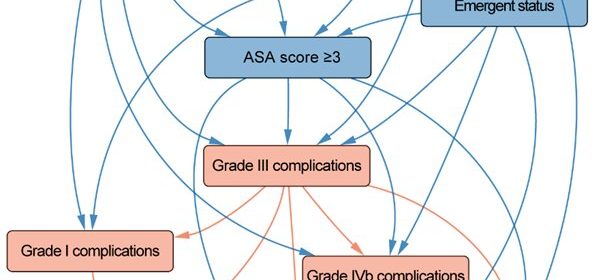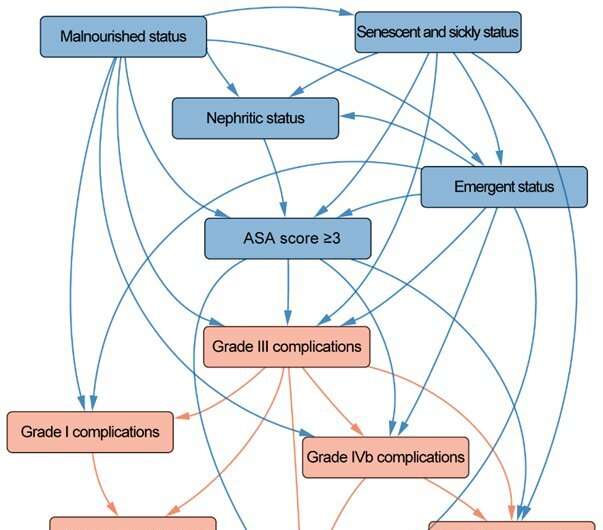A system for innovative grading, cluster visualization, and precise prediction of surgical complications


A research team analyzed 51,030 inpatient surgical cases from six different surgical departments at four large tertiary hospitals in China to develop a system for grading, cluster visualization, and precise prediction of surgical complications.
The team utilized a Bayesian network modeling approach to conduct a dual-track and parallel evaluation of the relationships among 17 commonly agreed-upon preoperative risk factors, 22 common complications, and death. The approach incorporated both the experience of a team of senior surgeons (54 members) and the potential natural structure of the data.
Ultimately, preoperative risk factors and complications were assembled into 11 clusters (i.e., 11 nodes, with 32 directed arcs representing direct associations and any two consecutive directed arcs representing indirect associations).
Three important results were obtained. First, the dependencies and interdependencies between the clusters were constructed by the directed arcs. For example, the Grade III complications (mainly comprising pulmonary infection) located at the center of the network directly depended on four of the five risk factor clusters and could trigger the occurrence of all other grades of complications.
Second, the probabilities of the occurrence of different grades of complications were simultaneously predicted under certain risk conditions. Using five risk factor clusters, the areas under the receiver operating characteristic curves for predicting Grade IVb and V complications were close to 0.9.
Third, a relatively simplified classification of different grades of surgical complications was achieved, with 22 types of complications and death being divided into five grades.
The three key features of this study are as follows. First, the study shifts away from viewing risk factors as the sole cause and instead focuses on the pathway from risk factors to the occurrence of complications, progression of complications, and ultimately deterioration (death). There is no absolute cause and effect, and complications themselves can also cause the occurrence of other complications. For example, the relative increase in the risk of death from Grade I to IVb complications ranges from 4.4 to 69.8 times the baseline.
Second, the risk factors and complications in the network are clustered, indicating that these naturally aggregated elements are formed by common mechanisms at their root, and intervening in the root causes of these clustered elements can have a significant effect on the prevention of complications.
Third, the occurrence and progression network of complications is in a dynamic balance with a chain reaction effect. Thus, it is important to focus on the key nodes in the pathway, and cutting off the occurrence of these nodes can have a significant effect on the prevention of all complications.
Professor Xiaochu Yu from Peking Union Medical College Hospital and Professor Jingmei Jiang from the School of Basic Medicine, Peking Union Medical College recently published these research results in Science China Life Sciences
This study reveals the transformational relationship among surgical complications in the perioperative period and provides two important insights for clinical management of complications: paying attention to the underlying factors that trigger surgical complications, and dynamically improving the targets of medical management of surgical complications to improve the safety level of surgical patients.
More information:
Xiaochu Yu et al, Network prediction of surgical complication clusters: a prospective multicenter cohort study, Science China Life Sciences (2023). DOI: 10.1007/s11427-022-2200-1
Journal information:
Science China Life Sciences
Source: Read Full Article